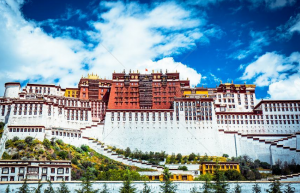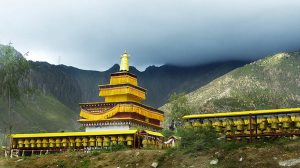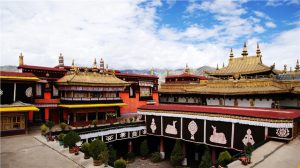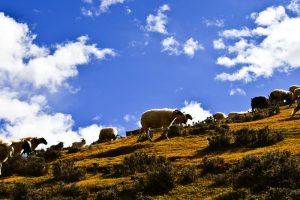
15 Days Tibet Mount Everest Advance Base Camp Trekking Adventure Tour [6340M]
![15 Days Tibet Mount Everest Advance Base Camp Trekking Adventure Tour [6340M]](https://mysterioustibet.com/wp-content/uploads/Mount-Everest-Base-Camp-in-Tingri-County-Tibet-13-788x396.jpg)
Tour Overview
Eastern side of Mount Everest was praised to be one of the “Top Ten Landscapes in the World” and “one of the top ten classic trekking routes in the world” by...
Code of Tour: YCT0000003175
Length of Travel: 15 Day
Destinations of Tour: Lhasa - Shigatse - EBC - Saga - Lake Manasarovar and Mt. Kailash - Zhangmu - Kathmandu
Departure City: Lhasa
Price of Tour: Request
Type of Tour:
Features of Tour: Nature Culture History Landscape
Eastern side of Mount Everest was praised to be one of the “Top Ten Landscapes in the World” and “one of the top ten classic trekking routes in the world” by American and British explorers last century. The whole trekking route is inside the Mount Everest Nature Reserve with overwhelming landscapes. The expedition crosses the Tibetan highlands and ventures into the Advance Base Camp of Mount Everest (North side) via trekking which is 6500m high above sea level. it is also the world’s highest Tibet trekking route that takes you as close to the summit of Everest as any non-climber can reach, with basic climbing gears and mountaineering skill. The trekking takes around 4-5days from Rongbuk Monastery and the 22km trekking route starts with Everest Base Camp (5200m) and trekkers move upwards along hills beside the Rongphu Glacier. Tourists are able to appreciate the peculiar shape of glaciers and then reach the Intermediate Camp(5800m) and keep heading upwards by passing the East Rongphu Glacier till the final destination—Advanced Base Camp (6500m), located alongside the East Rongphu Glacier. You will see broad-leaved forest, needle-leaved forest, brushwood, Alpine meadow, Alpine desert, permanent snow zone, majestic snow-capped mountains and glaciers on the way.
Highlights:
- Experience one of the top ten classic trekking routes in the world.
- Trekking inside the Mount Everest Nature Reserve with the most beautiful sceneries.
- Appreciate the top mountains of the world on your way including Mount Everest (World first) and Mount Lhotse (World fourth), etc.
- Enjoy your stay in local ethnic villages to fully appreciate the daily lives and ethnic cultures of local people.
- Experience Tibetan Buddhism in significant monasteries in Lhasa.
Brief Itinerary
- Day 1: Lhasa Arrival
- Day 2: Lhasa
- Day 3: Lhasa
- Day 4: Lhasa-Gyantse
- Day 5: Gyantse-Sakya
- Day 6: Sakya-Rongbuk
- Day 7: Rongbuk-EBC
- Day 8: EBC-Base Camp 1
- Day 9: Base Camp1-Interim Camp
- Day 10: Interim Camp-Base Camp2
- Day 11: Base Camp2
- Day 12: Base Camp2-EBC
- Day 13: EBC-Shigatse
- Day 14: Shigatse-Lhasa
- Day 15: Lhasa Departure
Google Map
Detailed Itinerary
Day 1 Arrive in Lhasa by air or by train[3660M]
Sightseeing and Activities:Arrive in Lhasa by air or by train[3660M]
Accommodation:Lhasa
Meals:None
After flying or taking train a long time to Lhasa, tourists will be greeted by our Tibetan tour guides at the airport, and a private car will take you to Lhasa. Tourists can get acclimatized to the new environment and explore freely in the old town of Lhasa. Stay overnight in Lhasa.
Day 2 Lhasa
Sightseeing and Activities:Potala palace,Johkang Temple
Accommodation:Lhasa
Meals:Breakfast,Lunch

In the morning, tourists visit the famous Potala Palace and explore the grandest of this myriad chapels, its audience halls, the jeweled and Golden burial chortens(stupa Tombs) of past Dalai Lamas, and tremendous number of Buddhist frescoes, thangkas, combinations of mandala, figures of the Buddha,made of precious metal. In the afternoon, we visit the holiest temple in Tibet, the Johkang Temple, built during songtsen gonpo’s reign by princess wencheng of tang dynasty, 647 A.D. The inner circuit is also situated inside the temple and is lined with prayer-wheel and murals outlined in gold on red background, which depict the thousand buddhas, interspersed with stupas and relief-images. Stay overnight in Lhasa.
Day 3 Lhasa
Sightseeing and Activities:Drepung Monastery and Sera Monastery
Accommodation:Lhasa
Meals:Breakfast,Lunch

Today, you will visit two important monasteries in Lhasa, the Drepung and the Sera. Drepung Monastery was situated at the foothill of a mountain and was once home to 10000 monks and Ganden podrang in Drepung was famous for its role as the governmental centre during the fifth dalai lama and later was moved to the famous Potala Palace during the fifth dalai lama.
After having lunch, we continue to visit Sera Monastery founded in 1419 by Tsongkapa’s disciple Jamchen Choeje. The most attractive scene is its monk debate held in the debating courtyard mostly around 3 – 5 in the afternoon. Stay overnight in Lhasa.
Day 4 Lhasa-Gyantse
Sightseeing and Activities:Yamdrok-tso,Kumbhum Monastery,Nanchan- Kangtsang glacier
Accommodation:Gyantse
Meals:Breakfast,Lunch
We drive towards Yamdrok-tso and Gyantse Kumbhum Monastery (300km) and run through a black asphalt highway. It is better to leave early in the morning and in about one and half hour way, from the top of Mt.Gangbala, you can see the fabulous shade of deep torquoise. Yamdrok-yutso is shaped like coiling scorpion with deep blue in colour. Leaving yamdrok-tso is a spectacular as arriving, since you have to cross the 4960m karo-la with its awesome roadside views of the Nanchan- Kangtsang Glacier. then we will reach our day’s final destination Gyantse, and visit Kubum monastery which is 35m-high chorten(stupa) with its white layers trimmed with decorative stripes and its crown-like golden dome. you can visit every chambers in the monastery. Stay overnight in Gyantse
Day 5 Gyantse [3950M] – Sakya [4500M]
Sightseeing and Activities:Drive Gyantse [3950M] – Sakya [4500M] 230km:TashiLhunpo monastery,Sakya monastery
Accommodation:Sakya
Meals:Breakfast,Lunch

Today’s itinerary covers the unique TashiLhunpo Monastery(90km), and we will drive through black smooth tar road to Sakya, and visit Sakya Monastery, then to Lhatse Visit the famous Tashilhunpo monastery which is one of the the six great Gelukpa institutions founded in 1447 by a disciple of Tsongkapa. In the evening you can visit the famous Tibetan market below the shigatse Zong. Then drive to Saykya county where the Sakya monastery is located, and the Sakya tridition is one of the four main Buddhist schools in Tibet. It was from here that the whole of Tibet was governed during the period of Sakya hegemony and even now there are buildings of historic importance to be seen here. You can see the largest book in the world in Sakya’s great library written in gold. Stay overnight in Lhatse.
Day 6 Sakya [4500M] – Rongpuk
Sightseeing and Activities:Drive Sakya [4500M] – Rongpuk [5000M] 256km:Sakya Monastery,Gyalpo-la pass,Rongbuk
Accommodation:Rongpuk Hostel
Meals:Breakfast,Lunch

In the morning, you will visit Sakya Monastery, which is one of the four main Buddhist schools in Tibet. It was from here that the whole of Tibet was governed during the period of Sakya hegemony and even now there are buildings of historic importance to be seen here. You can see the largest book in the world in Sakya’s great library written in gold. After exploring Sakya Monastery, we will drive directly towards the Mount Everest Base Camp(180km)Rough road upto mount Everest. From the top of the Gyalpo-la pass you can see the beautiful sun raising from the top of great Himalayan mountains. Stay overnight in Rongpuk Tent Guest House
Day 7 Rongbuk to EBC
Sightseeing and Activities:One day adjust trekking from Rongbuk to EBC, camp at EBC. [5200M,8km,3-4hours]
Accommodation:Camping
Meals:Breakfast,Lunch
Today warm-up trekking from Rongbuk Monastery to EBC, you will see the famous Rongbuk Glacier, which is the largest among all the hundreds of glaciers formed around the Mt. Everest. The glacier water flows south into a river passing by the foot of the monastery. This is called ‘Rongbuk River’, and the water there is extremely cold. Camping at EBC.
Day 8 Everest Base Camp to Camp 1
Sightseeing and Activities:Trek from Everest Base Camp to Camp 1 [5460M,5km,5-7hours]
Accommodation:Camp 1
Meals:Breakfast,Lunch
Your first challenge would be trekking to Base Camp 1(5450m). Going through the Rongpuk Glacier along the way to C1, you many enjoy this massive glacier. We will take a trail that rises to the east side of this ice cap and heads toward the peak of Mt. Everest. The trek is fairly short, but the high altitude may still be hard for many, so relax today and enjoy exploring this amazing area. Stay overnight in Camp 1.
Day 9 Trek to Interim Camp [5760M,6km, 6-7hours]
Sightseeing and Activities:Trek to Interim Camp [5760M,6km, 6-7hours]
Accommodation:Interim Camp
Meals:Breakfast,Lunch
Our trekking trail today will begin from gravel hills to the west of the glacier. Another scenic day awaits us as we spend the night at the interim camp. Ice pinnacles surround us in all directions. What an amazing experience! Stay overnight in Interim Camp.
Day 10 Trek to Camp 2
Sightseeing and Activities:Trek to Camp 2 [5970M,5km,6hours] sometimes in summer season, the river floods, yaks can’t cross it, then today we start from interim camp(5760m)early and reach ABC and return to interim camp(5760m).
Accommodation:Camp 2
Meals:Breakfast,Lunch
Today we ascend even farther to the intricate maze of ice as we meet up with the Changste glacier. It is such an incredible experience to hike on the world’s highest mountain! Today our camp is even more beautiful than past sites. We are surrounded on all sides by varying glaciers and hanging ice. Stay overnight in Camp2.
Note: sometimes in summer season, the river floods, yaks can’t cross it, then today we start from interim camp(5760m) early and reach ABC and return to interim camp(5760m).
Day 11 Trek to ABC [6500M] and return to Camp 2 [5970M,6km,9hours]
Sightseeing and Activities: Trek to ABC [6500M] and return to Camp 2 [5970M,6km,9hours]
Accommodation:Camp 2/Camp 3
Meals:Breakfast,Lunch
It is completely up to you today to decide whether you want to spend the night at Base camp 3 or simply hike there during the day and return to Base Camp 2. The walk will be much more enjoyable tomorrow if we stay at the second base camp. However, if you wish we can spend the night at an even higher altitude and impressive location. Camp 3 lies in the center of flattened gravel mounds next to the glacier. Today we can observe many imposing pinnacles, ridges, and even the rock summit of Everest. Camp 3 is only 2400 meters from the top. What a sight it is to finally arrive at nearly the highest point in the world!
Day 12 Return to EBC [5200M,16km,10hours],then drive to Tent area or Rongpuk guest house
Sightseeing and Activities:Return to EBC [5200M,16km,10hours],then drive to Tent area or Rongpuk guest house
Accommodation:EBC
Meals:Breakfast,Lunch
Today is a long day as we cruise downhill back towards the first base camp. Wonderful sights as we leave this amazing peak.
Day 13 Rongpuk-Shigatse 350km
Sightseeing and Activities:Rongpuk-Shigatse 350km
Accommodation:Shigatse
Meals:Breakfast,Lunch
Make your way back to Lhasa, and stay one night at Shiagtse.
Day 14 Drive Shigatse to Lhasa 280km
Sightseeing and Activities:Drive Shigatse to Lhasa 280km
Accommodation:Lhasa
Meals:Breakfast,Lunch
Continue your way back to Lhasa. Transfer to hotel for rest then.
Day 15 Leave Lhasa by air or by Train
Sightseeing and Activities:Leave Lhasa by air or by Train
Accommodation:None
Meals:Breakfast
See you off at Lhasa train station or at airport
Recommended Hotels
| Destination | 5 Star | 4 Star | 3 Star |
| Lhasa | Luxury St. Regis Lhasa Resort | Lhasa Gang Gyan Hotel | Lhasa Xiongbala Hotel |
| Gyantse | / | / | Gyantse Hotel |
| Saga | / | Xibu Yizhan Hotel | Brahmaputra Hotel |
| Shigatse | / | Shigatse Manasarovar Hotel | Jiumu Yamei Hotel |
Service Included:
-
Tibet travel permit and all other necessary permits to Tibet;
-
All entrance ticket fees for all tourist sites listed in the itinerary;
-
Personal knowledgeable English-speaking Tibetan local tour guide;
-
Personal comfortable, clean and safe vehicle with reliable Tibetan local driver; vehicle ranging from 4WD land cruiser to minibus depending on your group size;
-
All lodging listed in the itinerary; it’s your decision about the accommodation class: luxury 5-star international hotel, comfortable 4-star hotel, economic 3-star hotel or budget hostel, guesthouse or tent. Please tell us your accommodation preference when submitting the enquiry; we will arrange the best-value hotels for you.
-
Domestic flight/train tickets listed in the itinerary;
-
All meals listed in the above itinerary.
Service Excluded:
-
International flight to and out of China;
-
Chinese visa (Note: we could help you with the Chinese visa application, like providing the invitation letter, presenting the hotel or domestic flight reservation copies, etc that you may need. )
-
Domestic flight/train not listed in the itinerary. (We can provide you the domestic flight/train ticket booking service at the BEST discount price; please contact us our travel experts for the details.)
-
Meals not specified in the itinerary; usually it costs about USD3-15 per person for one meal in TAR (Tibet Autonomous Region).
-
Tips and gratitude to tour guide and driver;
-
Personal expenses, like laundry, phone call, snacks, soft drinks (please do the best to avoid the alcoholic beverages during your Tibet trip), optional tour activities, etc.
Travel Tips:
- Tibet Permits
There are several permits required to visit Tibet. Tibet Entry Permit, issued by Tibet Tourism Bureau, is the most important one which has to be obtained before your trip because you must have it to take your flight/train to Tibet. To get the permit, you have to book a Tibet tour with us, and send us your passport and Chinese visa about 20 days in advance, and then let us apply for the permit (all Tibet permits can only be applied by travel agency). If you travel to other prefectures like Shigatse, Nyingchi, Shannan, etc, you also have to obtain an Alien Travel Permit. If you travel to Mount Everest, you have to obtain a Border Permit. (Tibet Discovery, with office in Lhasa, has always kept up with the latest news on Tibet Permits. Traveling with us, all your permits are guaranteed as long as you are qualified to the requirements.)
- Available Months to Visit Tibet
Generally speaking, May to early October is the best time to for a Mount Kailash trip. July and August are the peak season and rainy season. It may be too cold to travel in Kailash area from November to March. There is usually heavy snow. The conditions in Namtso Lake and Mount Everest area are quite similar with Kailash. While other places like Lhasa, Gyantse and Shigatse are suitable for travel all year around.
- High Altitude Sickness
The average altitude of Tibet is about 4000 meters above the sea level (Lhasa: 3700m; EBC: 5200m; Namtso: 4718m). You may suffer a bit from High Altitude Sickness in the beginning days of your Tibet trip if you haven’t had rich high plateau travel experience. But don’t worry too much, the high altitude can be acclimatized usually in 2~3 days. Our suggestion is to take a physical examination and get suggestions from your doctor, and also bring some medicines to prevent from High Altitude Sickness before your trip. While in Tibet, you should keep warm all the time, avoid strenuous activities, drink more water and eat more vegetables and carbohydrates. You’d better not take showers during the first two days after your arrival at Tibet. If you don’t feel well, get help from your tour guide or go to the hospital without any delay.
- How to Go to Tibet
Basically you have two options – flight and train. Currently, you can take a flight to Lhasa from Beijing(4.5hrs), Xian(3.7hrs), Chengdu(2.5hrs), Chongqing(3hrs), Kuming(3hrs), etc. Among all these cities, Chengdu and Xian have more frequent flights to Lhasa. Kathmandu also has several flights to Lhasa each week.
If you a train travel, you can take a train to from Beijing(40.5hrs), Xian(32hrs), Chengdu(43hrs), Shanghai(47hrs), Chongqing(42hrs), Lanzhou(25hrs), Xining(22hrs), Guangzhou(54hrs).
- Packing and Wearing Ideas
Firstly you can’t forget your passport and Chinese Visa. A large backpack and a smaller one are recommended (the smaller one can be used for daily activities). Also bring the necessary medicine you need. Other stuffs like sunglasses, snow glasses, hats, lip balm, sun block are recommended. As for wearing, you are suggested to dress in layers (both thin and thick jackets). Down jacket is necessary in Spring and Autumn. A pair of durable and comfortable shoes is necessary.

















